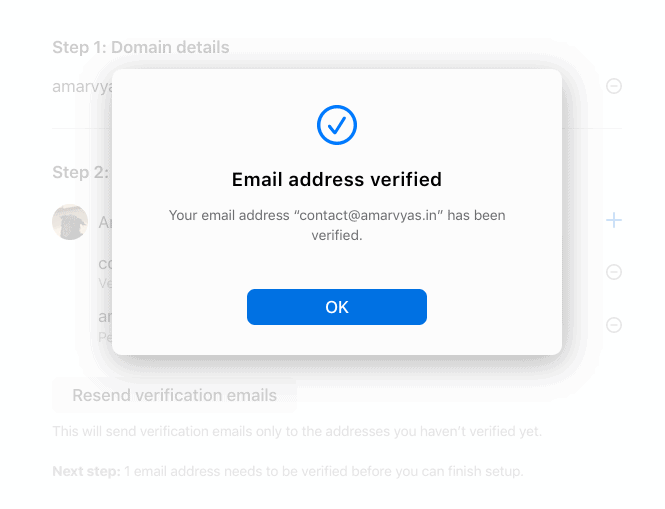Email providers across the years
This post was previously published as My Journey with Email ServicesAmong the earliest services I used, two stand out- Hotmail and Yahoo Mail. Hotmail, launched in 1996, was among the earliest webmail services, known for its free email offering and integration with MSN Messenger. While it merged into Outlook.com, its legacy remains as a pioneer in the online communication landscape. Yahoo Mail, established in 1997, pioneered webmail, offering ample storage and introducing features like spam filters, although its popularity has waned. The period late 1990s and early 2000s saw me using services like mail.Excite, MailCity, RocketMail, and Lycos. And of course, the omnipresent (atleast at that time) AOL Mail. Most of these services have been discontinued or merged with other services. Gmail, started in 2004 as an invite-only beta, and was publicly launched in 2007. It edefined email services with its large storage, threaded conversations, became the omnipresent (almost) service for many people in less than a decade. Gmail also effectively answered the question: How many email services do you need ? And the answer was – One. (Many people still have multiple gmail accounts, and the continue to have accounts with other email service providers.. but that is a different story.) For disposable email needs, LastMX and Firefox Relay generate temporary addresses for privacy-conscious users. So does Apple mail in the premium version of iCloud mail.Other providers like Zoho, Yandex, ProtonMail, Tutanota, Mailbox.org, OperaMail, Nextcloud-based services, Disroot, and Vivaldi cater to diverse preferences, offering various levels of security, privacy, and integration. Majority of them offer webmail access only in their free tier. imap or pop service, which allows receiving messages to email clients or email inbox, are offered in paid or premium plans. For this blog post, I tried to create a list of email services I have used since 1997- arranged in (mostly) chronological order. Below is an exhaustive list of the different email services I have used over the years.For your personal or small business email needs, do you use one of the large, established email providers like Outlook (Office 365) or Google Apps? Or, do you use the free gmail (or yahoo, or outlook or yandex account), Or maybe you have an Apple account and use the icloud service?

At gaathastory and also for my personal blog, we do not use any of the above email providers. In this post, I will talk about “alternative” email service providers. Before that, let us get to the basics. Note that the below timeline only includes personal or work related emails, and not transactional email or relay message systems that are used by high volume senders. Such plans usually have a cap on number of emails per user in order to protect sender reputation. Such types of email are offered as premium marketing email services, and are beyond the scope of this post.
My Personal Email History: How many Email Services Used
Take a walk down memory lane as I share my experiences with various email service providers throughout the years. Hotmail to Protonmail, and find out which one has been my favorite!
1997-2000
- Hotmail: As is the case with many people I know of, Hotmail was the first email service I used. I also recall the name of my account (netscapenavigator4point7@..). I had a second account which I used as a backup account for applying to graduate schools in the US. Launched in 1996, Hotmail was one of the first webmail services. It was acquired by Microsoft in 1997 and later rebranded as Outlook.com in 2012.
- BSNL.net.in: BSNL (state-owned telecommunications company in India) that offers email services to its customers who have email plans. Its email service/ account I used primarily for applications to US schools.
- Excite, MailCity, RocketMail: I briefly experimented with the services – Excite, MailCity/Lycos, RocketMail/Yahoo. These were popular webmail services till the early 2000s. Excite and Lycos are still active, while RocketMail was acquired by Yahoo and MailCity was acquired by Lycos.
2000-2005
- Yahoo Mail: Another popular choice. Launched in 1997, Yahoo Mail is still active today. It offers features like 1 TB of storage and integration with other Yahoo services.Yahoo
- AOL Dial-Up: Launched in 1993, AOL mail is a free webmail service that is still operational. It offers features like unlimited storage and spam protection. My email account came with their dial up internet service,which I used while studying in the US.
- I continued to have an account with excite.com thanks to the ISP who had a tie up with this provider.
- PoetMail.net: This service was provided with dial-up internet access but is no longer available.
- edumail.nic.in: This was a student email service in India by National Informatics Center (NIC) but its current status in 2023 is unclear.
- Grad school in the US: Provided by the University of Illinois at Urbana Champaign while I was enrolled for my Master’s Program. This account was cancelled once I graduated.
- Alumni Network ID: From 2004 onwards. This service however seems to be discontinued now.
2005-2010
- Gmail: Launched in 2004, Gmail offers features like large storage capacity, search, and integration with other Google services such as google calendar and google drive.My first account was created in 2005-2006, with more created in subsequent years.
- Three different corporate accounts in the US: Held between 2004 and 2008.
2010-2015
- Master’s at IIM Ahmedabad: This service is a Google Apps hosted service, still active as of 2023. (Now known as Google Workspace for Education). It offers email and other collaboration tools.
- Corporate email accounts: Email accounts from four different organizations in India.
2015-2020
- My podcasting venture, gaathastory: Domain-specific email. This is hosted on Zoho mail, a mail service with features like custom domain support and integration with Zoho’s suite of productivity tools.
- Outlook.com: Launched in 2012, Outlook is a webmail service from Microsoft that replaced Hotmail. It offers features like integration with other Microsoft services and advanced email organization.Interestingly enough, I signed up for this service with a Gmail account.
- iCloud: Gained with the acquisition of an iPhone. Launched in 2011, iCloud is an email and cloud storage service from Apple. It is available to Apple device users and offers features like seamless integration with other Apple services. I have a paid subscription to iCloud, so I get to use the email relay, multiple domains and expanded mailbox with
- Live.com: This domain is now part of Microsoft’s Outlook.com service, which replaced Hotmail.
- Domain-specific email (Amarvyas dot in): Presently active, which I use via MXRoute. This is a hosted email service that provides custom domain email hosting with features like unlimited email accounts and spam protection.
2020-2023 Other email providers
Other email providers
Note: I have discontinued all of the below services as on January 2024.
- Yandex: A Russian webmail service that offers features like custom domain support and integration with Yandex’s other services.
- Tutanota: A secure, encrypted email service with a focus on privacy.
- Mailbox.org: A secure, privacy-focused email service with features like custom domain support and integration with productivity tools.
- OperaMail: A discontinued webmail service from the makers of the Opera web browser.
- Nextcloud-based services and Disroot: These services offer email and cloud storage with a focus on privacy and open-source software.
- Vivaldi: A webmail service from the makers of the Vivaldi web browser, which was tried and discontinued by the user.
- Other domain-specific emails: Custom email addresses that use a specific domain name, often provided by web hosting or domain registration services. These have been moved to Cloudflare ‘s email routing for forwarding any emails to my main account(s).
- LastMX and Firefox Relay: These services provide disposable email addresses for temporary use and increased privacy.LastMX, Firefox Relay
Overview of some hosted email providers I have used
MxRoute : they are one of the most mentioned, well regarded (or maligned, depending on who you ask) services. The opinions of most people are positive. Others have offered extreme feedback because of lack of support or the policies of this provider. You might want to check out the blog posts on how MxRoute email delivery works. Additionally, blog posts on MxRoute’s site as well as this post on blog by user Bikegremlin on LowendSpirit forums has some good introduction level information. You can also check out the review of MXroute by WPJohnny. Zoho offer a freemium service, we use the Paid plan for gaathastory. Previously, they used to offer imap service under their free pla, but that is no longer the case. The Free plan is limited to 5 users per domain. Their server locations are in the US, Europe, India (Chennai) and China. The website / desktop clients are fast and responsive, for some un explainable reason all of Zoho apps on my iOs device do not load up the sign-in page so I do not use those apps anymore. Yandex mail– Many people have misgivings about them. I had used them briefly in the past, before moving to zoho mail.You can connect multiple domains for free, and their service qas quite speedy and responsive. The desktop and mobile apps worked well when I last used then in 2018/19. Inbox.eu : This Latvia based company offers two plans- Personal and Business. I had used inbox.eu in the early days of baalgatha, and am quite pleased with the service. I would recommend you check it out! I have written an in depth review of inbox.eu on this blog.Using email aliases

If you do not want to give away your real email address to anybody, you can use an email aliasing service. This is a good way to masquerade your real email, and minimize amount of spam emails. Needless to say, with the evolution of email services and providers, the issue of spam has also evolved Here are a couple of examples: Improvmx and Lastmx.Use my post titled “How To Use eMail Relay Service” that covers this topic in detail. Altmail is one such option.

Mandatory email sign ups for many websites
Wrapping it up
My first introduction to email was via the Unix terminal in the early 1990s when I was in school. I believe it was a VAX system. This was followed by Hotmail, and brief dalliances with Yahoo, Rocketmail, excite, Mailcity (now Lycos Mail: in 2023, they still exist, though as a paid service since 2018.) When I was in graduate school, I first became familiar with a .edu email address. This was towards the turn of the century. I did indeed have an @ aol.com email address once upon a time ! Three decades of email use has taught me a thing or two – barring a few exceptions, no service (or service provider) lasts “for a long time.”forever”. In other words, the “forever free” account is a myth. You are responsible for maintaining your own backups, and updating the email address/ records periodically. There is much more to email than hosted email. Using email aliases, relays, etc. are some of the topics that I would like to include in a forthcoming post.We are halfway into the first quarter of 2023. My current email address (and domain) have been around for nearly 3 years. Let us hope we cross into the next decade!Conclusion and Reflections
This post so far has been about the services I have used. Which makes me curious: How Many Email Services have you used (or currently have?) Do write in the comments below. My reflections and exploration through the years of email services raises the question, how many email services do we truly need? At present, I actively use four email accounts, suggesting that for different purposes (professional, personal, and specific projects), a handful of email accounts seem to suffice. Looking to the future, the plan is to continue with three active accounts, tidying up services with these key emails and phasing out the rest. The takeaway is the realization that while the diversity of email services may seem chaotic, it is manageable and, in some cases, necessary to keep our digital lives organized and compartmentalized. For most people, a few accounts serving different purposes would suffice. It’s all about finding a balance that suits our individual needs.Links and Resources:
The following sites proved valuable in research and validation of details for this post: History of email- Wikipedia What are the different email providers- Quora Archive.orgThis post so far has been about the services I have used. Which makes me curious: How Many Email Services have you used (or currently have?) Let me know your thoughts and experiences with different email services in the comments below!
 To learn more about email providers, please visit this page. Or, read additional blog posts about email services by following this link. This post was updated on 25 February 2024
To learn more about email providers, please visit this page. Or, read additional blog posts about email services by following this link. This post was updated on 25 February 2024


